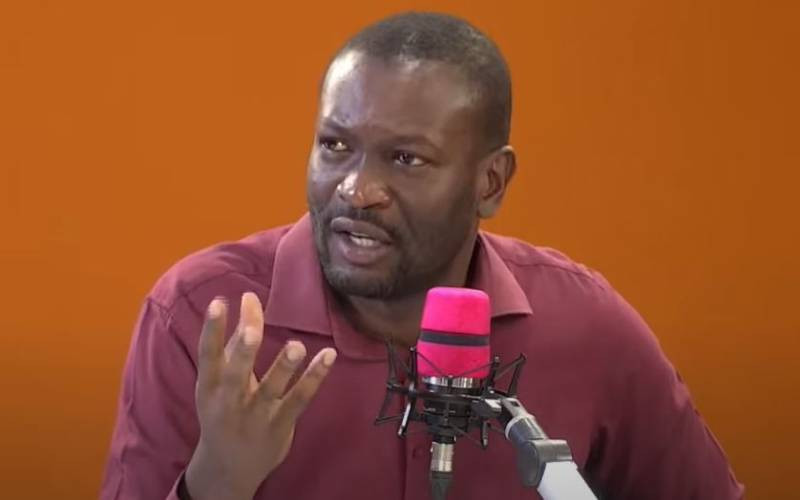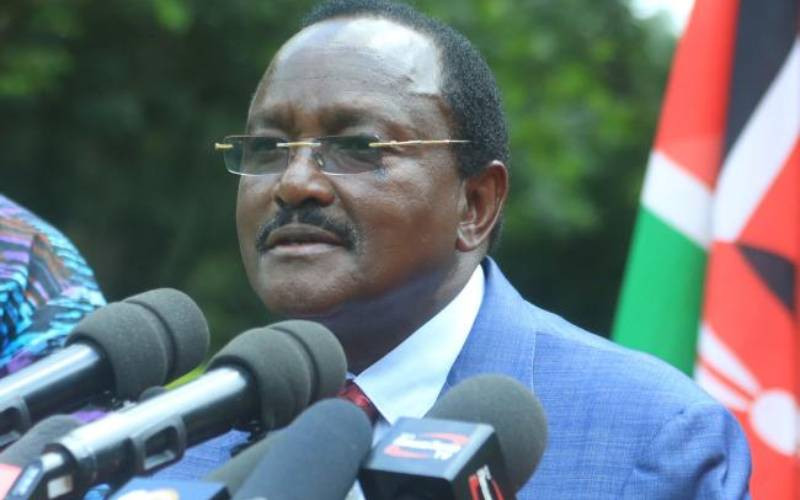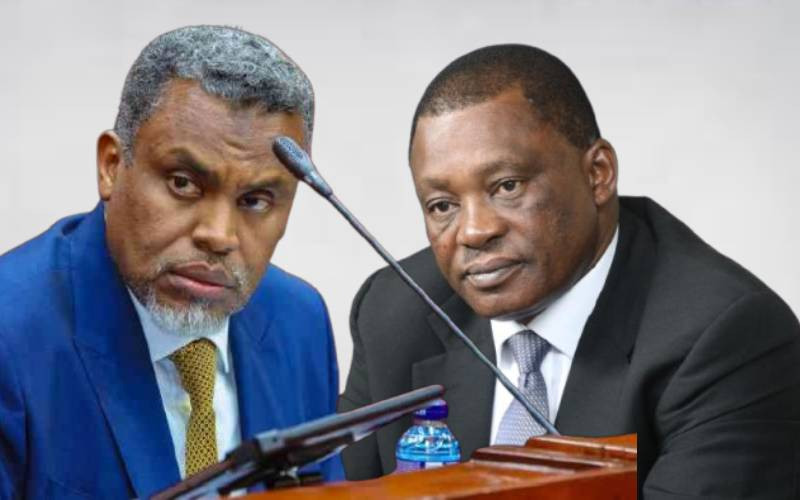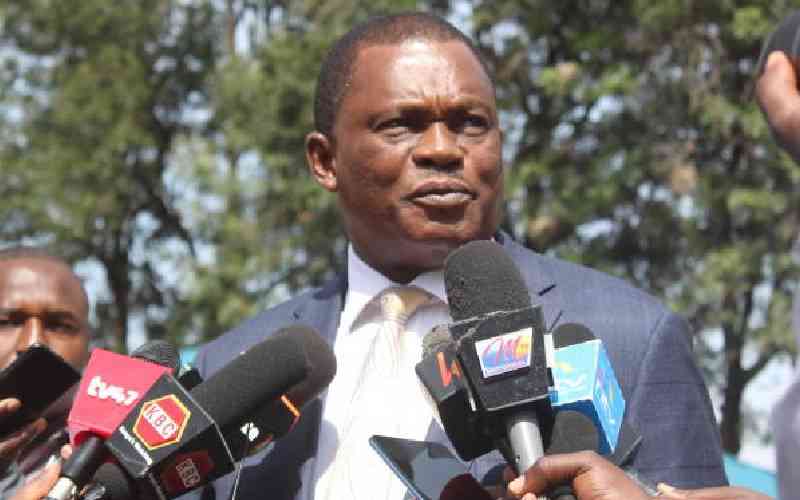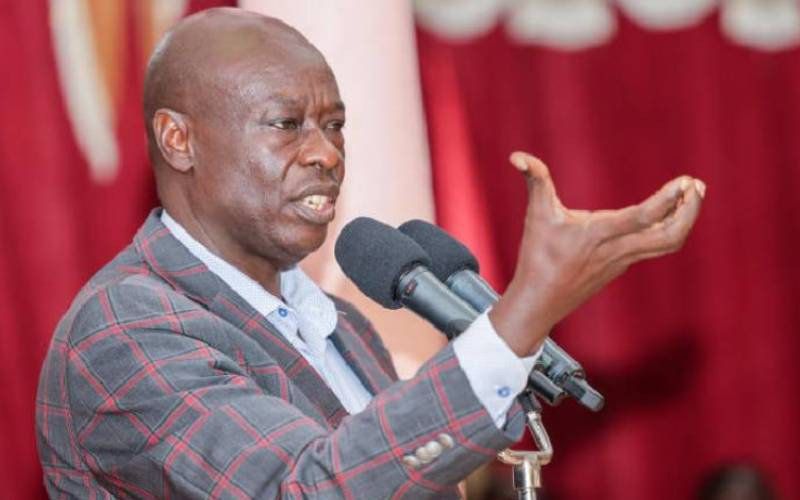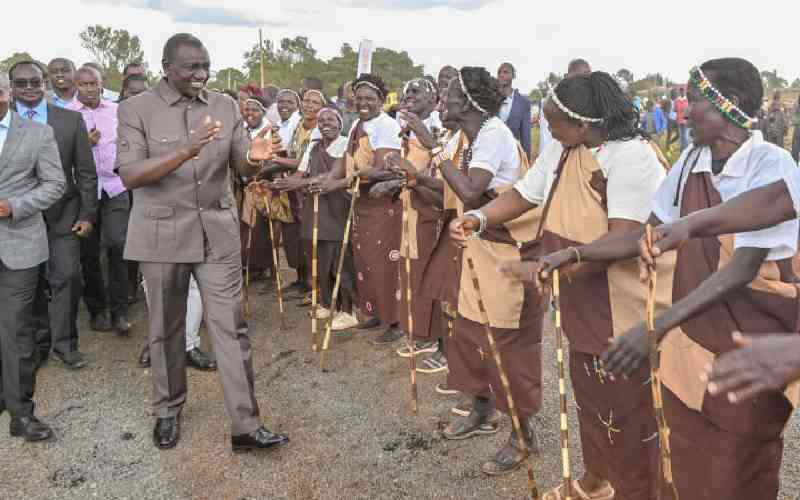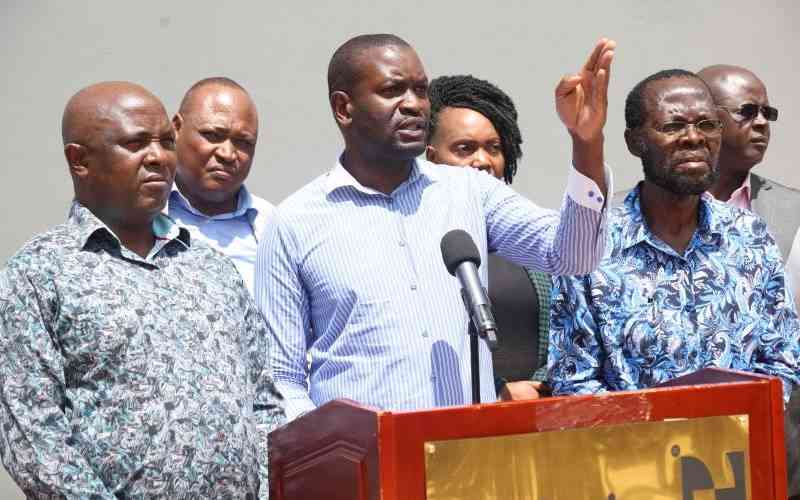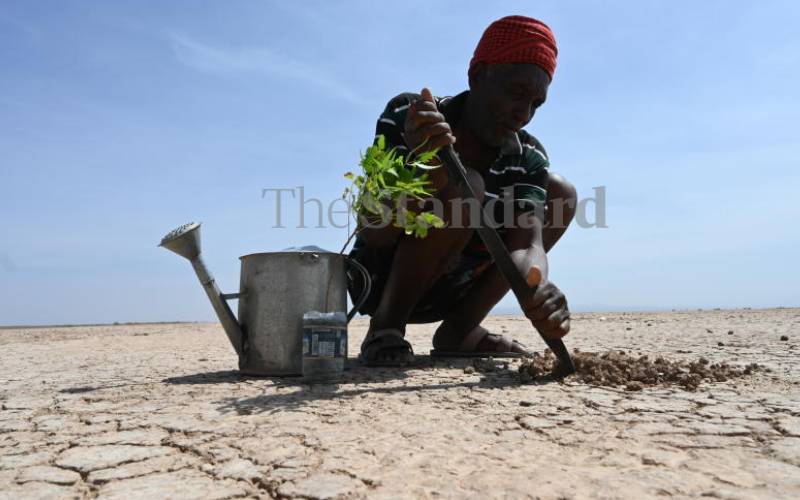
Dabaso Kantoma Sora planting a drought-resistant seedling at Chalbi desert, North Horr, Marsabit County. July 2021. [Denish Ochieng, Standard]
The 7th Devolution Conference in Makueni was an opportunity to review the outcomes of the 26th meeting by parties to the UNFCCC in the UK last November. Did we get anything in Glasgow? Vihiga Governor Wilber Ottichilo, who chairs CoG’s Environment and Climate Change Committee, spoke to The Standard on this and more.
What is your take on COP26? What did Africa and Kenya gain?
At the Glasgow conference that brought the world together, all agreed that climate change is a threat to our survival and that we must take serious drastic actions to mitigate or lower rising of temperatures by not more than 1.5°C. We also agreed that developed countries, like China, give more funds to developing countries for adaptation.
Climate change affects Africa more than any other region. But through our own mechanisms, we must also try to do what we can. That is why the Climate Change Act of 2016 says the National Climate Change Fund be set up and domiciled in Treasury for people to access money for mitigation and adaptation programmes. We also have the County Climate Change Fund.
The World Bank recently launched the Financing Locally Led Climate Action Programme (FLLoCA), which is expected to build resilience in grassroots. How does this work?
FLLoCA was initiated in Madrid in 2019 when I led a delegation of the Council of Governors (COG) to COP25. It is while there that Treasury and I engaged World Bank on the need to have funding to mainstream climate change to national, county and ward levels... and in 2020 we started formulating the project.
Fortunately, it was successful and World Bank approved it this year in September. What this five-year project aims at is to build capacity at the local level. Toxic emissions come from everywhere, even in villages. Another aim is to enable local people to come up with climate change adaptation programmes. The 47 counties will each receive Sh11 million for capacity building.
Counties are required to form the Ward Climate Change Planning Committees and County Climate Change Planning Committee. All these committees and local people will be trained, then afterwards each ward will be required to formulate project proposals on adaptation on themes such as land reclamation, water, reforestation, conservation, and river valleys.
The proposals will then be forwarded to County Climate Change Planning Committee for approval. Once approved, they will be taken to a committee in Nairobi consisting of members from Treasury, COG and Ministry of Environment for evaluation before funding of successful ones. There is no programme of this nature in the whole world! It was even acknowledged in Glasgow.
“Multi-Level Governance for Climate Action.” Why this particular theme for the 7th Devolution Conference?
The committee preparing the conference, working with COG in 2019, agreed that climate change was a global pandemic, as Covid-19 is today. We had consensus that without dealing with climate change, all our development endeavours would come to a nought because it affects every form of human life. Climate change impacts directly and negatively on food production systems.
This is the only planet with life although there are attempts to find out whether there is life on Mars. Climate being a key parameter that determines life, if it is disturbed, human life gets disturbed. There is risk of getting extinct or being wiped out of the planet. It affects health, agriculture, infrastructure, to mention but a few. We, therefore, decided to focus on climate change so that in our future County Integrated Development Plans, we can mainstream it in activities and programmes.
What are the steps the COG hopes to take to complement the little Kenya got at the negotiations?
We want to allocate resources within our budgeting process. We are dependent on agriculture, if we do not come up with adaptation mechanisms to continue food production; climate change will harm our agriculture. But we welcome funding and support from bilateral and multilateral partners from around the world.
How is the COG ensuring individual counties’ alignment with the SDGs, especially SDG1 to 7, 14 and 15?
All these SDGs touch on human life. For instance, if you talk about Health (SDG3) you are talking of climate affecting temperatures that cause more pathogens. This results in diseases like highland malaria because mosquitoes thrive in high temperatures. SDG13 is Climate Action, which counties have taken seriously. SGD14 is about Life Below Water.
The sea is directly affected by climate change. It is becoming warmer. The sea is rising. Some of the islands and coastal towns like Mombasa are being submerged. Up to 40 per cent of the world’s population lives in coastal areas. For SDG15 (Life on Land), think land degradation, biodiversity and wildlife among others. Climate change combines all the SDGs. Establishment of Climate Change Act in several counties is a big milestone.
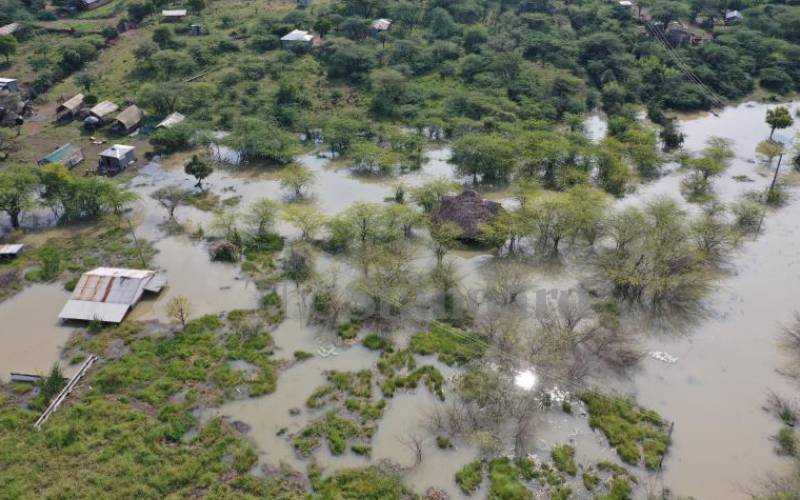
An aerial view of submerged buildings near Lake Baringo, August 2020. [Kipsang Joseph, Standard]
2021 marked the start of the Decade of Action to achieve the 17 SDGs. Where is Kenya, with one year almost gone, especially on awareness and mitigation of climate change?
First, we have to agree that Kenya is a victim; the climate crisis has been caused by rich countries that use fossil fuels, which release a lot of carbon dioxide, causing heating of the planet. Kenya contributes only 0.3 per cent of the emissions. But that does not mean we don’t act. As a signatory to the Paris Agreement, we must work together.
Kenya has done exceedingly well. It was the first in Africa to formulate National Climate Change Response Strategy (2009). It has other legislations such as National Climate Change Implementation Plan (2012 -2018, 2018 – 2022), National Climate Change Act (2016), National Green Economy Strategy and National Strategy on Climate Financing. We also have the Climate Change Directorate and have ensured all 47 counties enact legal instruments to combat climate change. Vihiga has Climate Change Act, Climate Change County Strategy, County Climate Change Action Plan and committees, to the wards, to ensure climate change is mainstreamed.
What are the efforts being made to build resilience in northern Kenya where there is drought every year?
Counties in Northern Kenya are highly susceptible to climate change. These areas experienced extreme weather patterns even before the apparent impact of climate change. That was in sync with nature at that time because these events recurred after every seven and 10 years. But with climate change, they are more frequent.
To build resilience in those counties, there is a programme funded through Treasury, which entails setting up water pans and boreholes. There is feeding of animals on harvested grass; or biogas, and people are also trained to de-stock or sell some of their livestock during drought. Furthermore, North Eastern people are advised to diversify activities, enabling irrigation that is now promoting food production.
What are the main opportunities for counties in climate action?
First, there is an opportunity now to learn different ways of living. We shall no longer do agriculture the way we used to. We have to shift from climate-based agriculture to irrigation agriculture. We have to stop depending on rivers and start harvesting and storing water.
Another opportunity is that to keep this planet alive we must plant trees. Climate change has also made us appreciate conservative farming where our soils need to be resuscitated due to the overuse of organic fertilizers. We have a chance to reinvent and live better in harmony with nature.
With the Kenya Climate Change Act in place, do you think implementation is at its best?
It is not at its best, but I believe with counties being very active, there will be no choice but to implement the National Climate Change Act that has many provisions that are yet to be implemented. For instance, the National Climate Change Council has not been constituted.
The president is the chairman and he admitted this in Makueni during the devolution conference. He needs to appoint the council. The climate change fund has not been activated despite parliament frequently allocating money to it.
What are the counties and the country lacking to ensure proper climate action?
We lack goodwill. We have the laws, now 33 counties have passed Climate Change Act. We need political and individual goodwill. We must have goodwill from individuals, households, communities, and counties up to the national level. We should be able to implement mitigation and adaptation activities that will address the problem of global warming.

Qura Laana, a herdswoman, walks her camels through Chalbi desert, North Horr, Marsabit County. January 2021. [Denish Ochieng, Standard]
How is the CoG contributing to the push to achieve 10 per cent forest cover?
Through my committee, we have agreed that counties continuously have programmes of growing and not just planting trees. At Maragoli Hills in Vihiga, we are not just planting trees in a colourful ceremony and leaving. We monitor their growth. We have fenced the land, recruited more environment officers and constructed an office block to coordinate activities at the forest.
We have over 20 per cent forest tree cover. I’m pleased to report that quite a number of counties are passing the 10 per cent forest cover mark. Nyandarua has over 40 per cent. One of the resolutions in Makueni was to ensure citizens plant trees equivalent to their ages in 2022.
How has the CoG has tackled gender mainstreaming in climate action?
“It is a process that we have started. Some of the counties had not started anything on climate change. Now it is through the county governments’ initiatives that climate change is taking centre stage for its mainstreaming. At the grassroots level, you can be sure the main people who will be involved will be women, youth and people living with disabilities because it is a requirement for them to be included in the climate change ward committees.
Through FLLoCA, gender mainstreaming is going to be a key component in the whole process. I believe if the project succeeds, both genders, people living with disabilities and other marginalised persons would have been sensitised, and as a result we will be able to determine quantitatively our national contribution to global warming. At the moment we do not have a clear mechanism of determining this.”
What are some of the achievements you can boast of as chairperson of the COG Committee on Environment?
I feel honoured to have been part of this journey that has created awareness on climate change in all counties hence becoming this year’s theme at the Devolution Conference. At the CoG level, all counties agree that climate change is a pandemic we have to deal with as it affects all sectors of our economy.
It is worth celebrating that through my committee, counties have enacted legal frameworks for climate change in less than two years. It took us over 10 years to enact the National Climate Change Act. I am optimistic that we shall not tire in the fight against climate change.
 The Standard Group Plc is a multi-media organization with investments in media platforms spanning newspaper print
operations, television, radio broadcasting, digital and online services. The Standard Group is recognized as a
leading multi-media house in Kenya with a key influence in matters of national and international interest.
The Standard Group Plc is a multi-media organization with investments in media platforms spanning newspaper print
operations, television, radio broadcasting, digital and online services. The Standard Group is recognized as a
leading multi-media house in Kenya with a key influence in matters of national and international interest.

